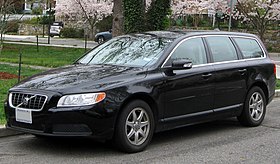Volvo XC70
| Volvo V70 | |
|---|---|

Volvo V70 (US)
|
|
| Overview | |
| Manufacturer | Volvo Cars |
| Also called | Volvo XC70 |
| Production | |
| Body and chassis | |
| Class |
|
| Body style | |
| Layout |
Front engine, front-wheel drive or four-wheel drive |
| Chronology | |
| Predecessor | Volvo 850 |
| Successor | Volvo V90 II |
| First generation | |
|---|---|

1999 Volvo V70 (AU)
|
|
| Overview | |
| Manufacturer | Volvo Cars |
| Also called | Volvo V70 XC |
| Production |
|
| Model years |
|
| Assembly | |
| Designer |
|
| Body and chassis | |
| Body style | 5-door estate |
| Platform | Volvo P80 platform |
| Related | Volvo S70 |
| Powertrain | |
| Engine | Petrol: 2.0–2.5L I5 (93kW–195kW) Diesel: 2.5L I5 (103kW) |
| Transmission | |
| Dimensions | |
| Wheelbase |
|
| Length |
|
| Width | 1,761 mm (69.3 in) |
| Height |
|
| Curb weight |
|
| Chronology | |
| Predecessor | Volvo 850 estate |
| Second generation | |
|---|---|

2001 Volvo V70 (AU)
|
|
| Overview | |
| Manufacturer | Volvo Cars |
| Also called |
|
| Production | January 2000–2007 |
| Model years |
|
| Assembly |
|
| Designer | Peter Horbury |
| Body and chassis | |
| Body style | 5-door estate |
| Platform | Volvo P2 platform |
| Related | |
| Powertrain | |
| Engine | Petrol: 2.0–2.5L I5 (103kW–221kW) Diesel: 2.4–2.5L I5 (93kW–126kW) |
| Transmission | |
| Dimensions | |
| Wheelbase |
|
| Length |
|
| Width |
|
| Height |
|
| Curb weight |
|
| Third generation | |
|---|---|

2008 Volvo V70 (US)
|
|
| Overview | |
| Manufacturer | Volvo Cars |
| Also called | Volvo XC70 |
| Production | 2007–2016 |
| Model years | 2008–2016 |
| Assembly |
|
| Body and chassis | |
| Body style | 5-door estate |
| Platform | Volvo P3 platform |
| Related | |
| Powertrain | |
| Engine | Petrol: 1.6–2.0L I4 2.0–2.5L I5 2.9–3.2L I6 (107kW–224kW) Diesel: 1.6–2.0L I4 2.0–2.5L I5 (85kW–158kW) |
| Transmission | |
| Dimensions | |
| Wheelbase |
|
| Length |
|
| Width |
|
| Height |
|
| Curb weight |
|
The Volvo V70 is an executive car manufactured and marketed by Volvo Cars from 1996 to 2016 across three generations. The name V70 combines the letter V, standing for versatility, and 70, denoting relative platform size (i.e., a V70 is a larger car than a V40, but smaller than a V90).
The first generation (1996–2000) debuted in November 1996 as the estate variant of the Volvo S70. Both cars were essentially redesigned Volvo 850s which had itself been available in saloon and estate configurations. The V70 was available as a front and all-wheel drive estate, the latter marketed as the V70 AWD. In 1997, a special AWD version called V70 Cross Country, badged as V70 XC, was presented and went on sale for model year 1998.
The second generation (2000–2007) shared styling by Peter Horbury as well as major mechanical commonality with the Volvo S60 saloon and was based on the P2 platform. With a 4 cm increase in width and height, a 5 cm longer wheelbase, a slightly shorter overall length than its predecessor, and a slightly increased interior cargo volume it went on sale in early 2000. As with its predecessor, the second generation was also offered as an all-wheel drive variant which was marketed as the V70 AWD and as a special version called V70 XC, which for model year 2003 was renamed to XC70 .
The third generation (2007–2016) was based on the Volvo P3 platform, sharing general styling and much of the interior in front of the b-pillar with the second generation Volvo S80. It has been marketed since 2007 as the V70 and the XC70, a crossover model.
Production of the V70 ended on 25 April 2016, the XC70 continued until May 2016.
The first generation V70 was an improved development on the basis of the Volvo 850 estate. Overall design became more rounded doing away with the 850's square edges. Among the many changes were a completely revised front end, fully painted bumpers and side trim and clear indicator lenses all around. Most of the interior was redesigned, with new seats, door panels and dashboard. According to Volvo a total of 1800 changes were made. Standard equipment was significantly improved over the 850 with remote central locking, heated & electrically adjustable mirrors, 2 front- and 2 sideairbags, power brakes with ABS and power windows being standard on every car. Trim levels varied for each market as did equipment levels of the most basic trims. In the United States, the badging denoted the engine variant and to some extent the equipment level, whereas in Europe engine and options could be chosen individually. In all markets more powerful versions received better or upgraded standard equipment. The T5 and R were the series high-performance models.
...
Wikipedia
